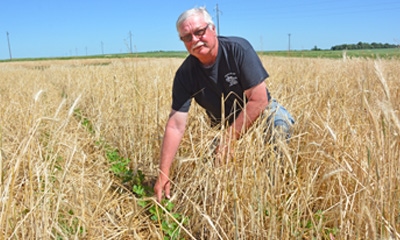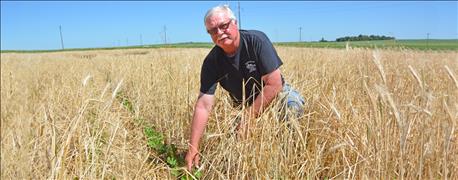July 15, 2016

When Bill and Linda Nelson bought his father’s farm 30 years ago, Bill set a goal of raising the soil organic matter to 6.5%. He was so serious about it that he wrote the goal down, like most people would write down a business plan.
At the time, the organic matter on the farm near Madison, S.D., ranged from 1.9% to 2.2%. Native prairie in the region had 5.5% to 6.5% organic matter.

BEANS IN RYE: Bill Wilson finds the soybean seedlings flourishing a few weeks after he planted the soybean seed in waist-high cereal rye.
Bill’s late father, Leonard, was a strong conservationist and instilled in Bill the importance of soil heath. Bill remembers how after evening chores his father would walk the fields to check crops and check the earthworm population with his pitchfork. He would talk about what would be planted the following year in each field and explain why.
But with his three sons in the Vietnam War, Leonard didn’t have anyone to continue the tradition when he retired in 1969. He rented out the farm for 15 years before Bill bought it.
Today, Bill has almost reached his soil organic matter goal — thanks to no-till, cover crops and a rotation of corn, soybeans, alfalfa, rye and other small grains.
“My soil organic matter now ranges from is 5.7 to 6.2,” he reports.
How he did it
Bill rotated corn and soybeans and tilled the soil for a couple of years after he bought it. But the yields were just average, and it was difficult and expensive to control weeds. Bill was anxious to return to his dad’s soil health focus. He also had to figure out how to cut costs to survive the farm crisis of the 1980s.
“There were more than a few times I wondered what I had gotten myself into by buying the farm,” Bill says.
Bill began cutting back on tillage. He planted more small grains, which required fewer inputs, and hired a neighbor to no-till plant 40 acres. He liked what he saw on the no-till fields. Six years later, everything was no-till.
Next, he found profitable markets for rye and other specialty crops to diversify his rotation.
“There are markets out there,” he says, “but you really have to work to find them.”
Finding a market for rye was key because rye suppressed weeds so effectively that Bill was able to nearly eliminate herbicide applications on some fields.
Next came cover crops.
“My dad planted cover crops, but he called them green manure crops, and he planted them mostly in the fallow year. Like everyone at the time, he thought the green manure crops had to be plowed under to get the benefits,” Bill says. “Now we know it is the roots that improve the soil quality.”
Bill rotates three or four different crops. His rotation is a cover crop mix planted in the stubble after harvest (leaving the straw in the field), followed by soybeans, corn, soybeans and back into small grain or alfalfa. Every couple of cycles through the rotation, he plants alfalfa and keeps the stand for several years. If a field of rye cover crop comes through the winter OK, he will let the volunteers grow and plant soybeans into them the following spring. The rye is often 3 to 4 feet tall and heading when he plants soybeans. Immediately after planting the soybeans, he sprays the rye with Roundup.
Bill introduced cattle back onto the farm, too. His father had milked cows and spread the cow manure back on the fields. Bill doesn’t own any cattle but custom grazes cover crops and corn stubble.
The system is working well, Bill says.
He’s never had a crop failure. Fields have never been too wet to plant. Rye and other cereals create a firm soil structure, which holds up the planter when it is wet. The cover crop also uses up excess moisture in the spring.
Corn and beans planted into cover crops have never been lost because it was too dry during the growing season, either. The stubble keeps the soil cooler (crops stop growing when the soil temperature gets too hot), and the tall stubble, especially from rye, filters the sunlight and protects young plants from blistering winds.
Financial results
Doug Vik, a former South Dakota Natural Resources Conservation Service economist, ran some numbers on how Bill is farming.
He spends 48% less on variable costs (chemical, fuel, labor) than if he were in a traditional corn-soybean rotation.
The chemical bill is 80% less.
Machinery operating costs are 25% less.
Labor costs are 50% lower.
Bottom line: Bill’s net return is 16% greater than if he were using conventional farming practices in a continuous corn or corn-soybean rotation.
Bill says his yields have greatly improved over the years.
“I am very happy with what we have been able to accomplish — it's been like having my teacher, Dad, right there with me.”
You May Also Like




